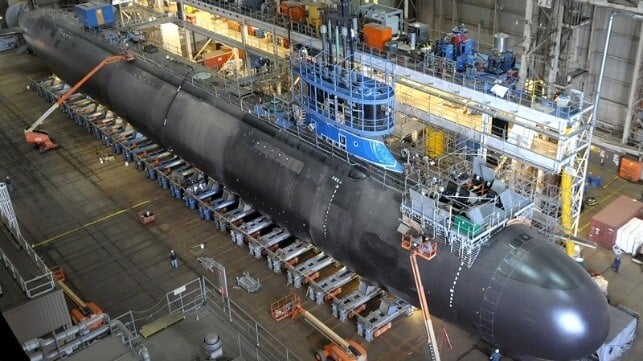Electric Boat Slows Down Sub Production Because of Delayed Parts

On Wednesday, in a confirmation of the concerns of U.S. Navy leadership, the head of General Dynamics said that her company would be slowing down the pace of construction on new submarines to match the behind-schedule pace of component deliveries.
GD's Electric Boat division and Huntington Ingalls Industries build the Navy's Virginia-class and future Columbia-class nuclear-powered subs. Beset by workforce and supply-chain issues, both programs have been hit with long delays - more than a year in the case of the Columbia-class. The Navy says that it can't afford to wait for its stealthiest and deadliest platforms in an era of great power competition, and it has invested billions in infrastructure and workforce initiatives to shore up the submarine industrial base, with unclear results.
In a call with investors on Wednesday, General Dynamics CEO Phebe Novakovic said that Electric Boat has been "severely impacted by late deliveries from major component suppliers," pushing back schedules and driving up costs. Though not specified, the "major components" could include USS Columbia's steam turbine, which manufacturer Northrop Grumman has had difficulty delivering on time, according to Secretary of the Navy Carlos Del Toro.
The delays have pushed the final assembly of subs at Electric Boat out of sequence, and some sections have been welded together before all components in each section are pre-installed. Because of the inefficiency of working out of sequence, the cost of completion rises by up to eight times for these segments, Novakovic said.
"There is no point hurrying portions of the boat only to have to stop and wait increasingly extended periods of time for major components to arrive. It is neither good for the boat over time nor cost," she told investors. "Our out-of-sequence work on modules weighing thousands of tons is time-consuming and therefore expensive."

that matters most
Get the latest maritime news delivered to your inbox daily.
Worker shortages are the most severe issue facing Electric Boat's subcontractors and suppliers, and the Navy recently allocated $1 billion to a workforce-development contract to boost employee recruitment and retention. The program will also support R&D work to scale up 3D printing and robotics technology for use in submarine construction.
The Navy's submarine suppliers need to increase production fivefold in order to meet strategic needs, and fast. The Navy is on a tight timetable to build replacements for the aging Ohio-class ballistic missile subs, the most survivable element of the nation's nuclear triad, while also delivering more Virginia-class boats for export to Australia. This could take as many as 100,000 new civilian shipbuilders and subcontractors, according to the service.
